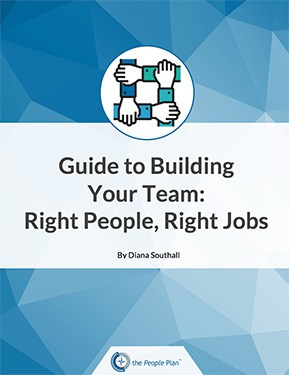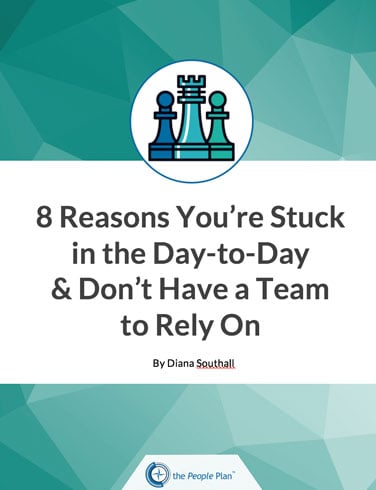
by thepeopleplan | Jan 5, 2013 | coaching, performance
Most small business/ small organization managers interact regularly with their staff members—assigning and coordinating work, answering questions and approving decisions, coaching on skills or techniques, “putting out fires,” and inquiring about progress and status of tasks you assigned.
This is an effective management technique, once dubbed “Management by Wandering Around” by Tom Peters and even given its own acronym MBWA.
The benefits:
Employees appreciate the wandering manager for her accessibility and just in time responses, and managers keep busy and deploy people and resources quickly.
How to improve:
However, MBWA tends to focus a manager’s time and staff’s attention on the daily tasks that consume the day—reacting and getting the job done. This often prevents managers from “getting to my list of projects”—our wish list of projects to improve our operations, customer care, revenue, and costs.
The solution:
In addition to ongoing feedback and coordination, also take time to debrief last year and plan for this one with each employee. Reviewing successes and planning for the coming year involves employees involves employees in creating a challenging and rewarding work plan that will increase their commitment and engagement.
There are several benefits of an annual review meeting with employees:
- Employees expect some type of “formal” review (in a sit down meeting, with written document to review)
- Builds trust and rapport with employees
- Allows employees an outlet to discuss accomplishments and concerns (last year) and job/ career goals (this year)
- Provides opportunity to recognize (and therefore reward with praise) an employee’s accomplishments
- Allows manager to find out what additional responsibilities and work would be challenging and interesting for an employee
- Discuss future department goals and how an employee’s job fits in
- Identify individual action plan items — items from manager’s project list that can be delegated and mutually decide a timeline and plan to accomplish
What should you discuss at this meeting? — here is a short list:
- What are the important achievements of the past year?
- What can be improved in your job to help you be more effective?
- How can I as your supervisor assist you?
- What skills or knowledge do you want to develop in the next year? How can this be accomplished?
So go ahead and schedule a sit down with everyone this month—
it can be lunch in your office, or off site for coffee, or what works with your style.
Your employees will appreciate your time and attention.
As an added benefit- you can delegate some of your “to do’s” to finally get to that wish list this year.
If you finished half your wish list — what could you celebrate at next year’s meeting?
Image courtesy of stockimages at FreeDigitalPhotos.net

by thepeopleplan | Nov 30, 2012 | rewards
Does your organization pay discretionary bonuses or “profit sharing” to employees this time of year? Year end payments have many names… bonus, incentive, profit sharing, gain sharing…
The majority of organizations make these annual payouts that typically cost 3-10% of employee pay, but are you getting any “bang for your buck?”
The plans (if you have one) range from the individual to the entire group, and from an entitlement to true pay for performance. Of sometimes managers just pick a number and add it to someone’s paycheck.
The communication ranges from a personal conversation describing the specific performance that earned this bonus, to a team bonus tied to specific profit or operation goals, or a “hey, boss, thanks for the bonus, what was it for?” Perhaps worst of all is “where is MY year end bonus?
When payroll budgets are tight and benefit costs are rising at alarming rates, perhaps your management team should take a look at your year end payments, and ask the following questions:
- What are the desired behaviors (performance) that we want to reward (that help us achieve our goals)
- Does the payout reward desired behaviors?
- Do recipients understand how their payment linked to organization goals? (and what they can do to earn more of this?)
- Does it follow our firm’s Three C rules that employee ask:
-Clear— what do I need to do to earn it?
-Control— how do I impact the results that impact the amount?
-(not) Complex— is the plan easy to understand how I earn it?
As much as everyone likes “extra” money during the holidays, perhaps the money you are spending on these could be more effective properly linked to performance or diverted to another part of your total compensation budget.
Image courtesy of David Castillo Dominici at FreeDigitalPhotos.net

by Diana Southall | Aug 2, 2012 | rewards
“Employees expect to be recognized when they do good work. Thanking employees for doing good work is not just common sense, it increases the likelihood that they will want to continue to do good work and serves as a catalyst for attracting and retaining talented employees you and your organization need to be successful.” Dr Bob Nelson.
Dr Bob’s research found that managers who used recognition reported that it assisted them to:
- Better motivate employees (90%)
- Increase employee performance (84%)
- Provide practical feedback (84%)
- More easily get work done (80%)
- Enhance productivity (78%)
- Better achieve their personal goals (69%)
- Achieve their job goals
Our July 31 blog post on feedback mentioned that ideally employees want about 6 praises for every 1 correction.
To ensure sure managers are providing this level of aligned praise, an organization should have a formal recognition program. Back to the Aberdeen report (read 7/31 blog post), 65% of Best companies have a formal rewards and recognition program compared to 46% of the lowest performers (and I will bet you $1 that the Best companies have better alignment of recognition with goal-specific employee activities).
I remember in college I had a supervisor (another student) who would also say “thanks for your help today” but this did not engender any sense of pride or accomplishment— and now I realize why. He did not specifically explain what I did that was good today, and lost the opportunity to encourage goal-specific activity next shift.
What conversation are your managers having with employees and how often?
Image courtesy of nongpimmy at FreeDigitalPhotos.net

by thepeopleplan | Jul 24, 2012 | Uncategorized
In my informal poll of employees and human resource professionals, most are not satisfied with the performance review process at their organization. The “annual review” is often the most dreaded event for employees and managers alike (hundreds of studies back up my personal polling results) go to this web-site. Don’t blame HR people—they have the best of intentions.
You see, employees crave performance feedback — really! (next week our blog post will focus on the value of feedback). The problem is that they are not getting enough between the “annual reviews” and that managers are not doing a very good job with the conversation during the annual review (or worse, the reviews are less frequent than annual or not at all).
Performance management is not just an annual event with a sit down conversation and simplifying an entire year of an employee’s conversation to a single number. The term performance management refers to all the efforts of peers, managers, measurement and systems that literally “manage” or guide an employee’s performance to do work that accomplishes an organization’s goals.
A terrific Aberdeen Group report found out what differentiated the “Best in Class” employers from the “Laggards” in the area of performance management. At Best in Class companies, 88% of managers reached agreement on performance goals between a manager and a worker (compared with 77% of others). Simple stuff that they should be doing, but how they did this was remarkable —83% of Best managers provided ongoing, informal feedback compared to 43% of the lowest performing companies.
Wait until you here the impact of having great managers that align and focus employee productivity—at Best in Class employers, these managers rated 71% of employees as exceeding expectations, compared to 20% of those employers with average performance to their industry and 13% of lower performing companies. (Also, 62% of employees at Best employers were engaged compared to 28% at laggards).
So this means that Best companies had 6 times are many Top Performers– no wonder they hit the ball out of the park compared to their competitors!
The study also found that there were reasons Best employers had more effective manager- employee conversations, as they provided tools and training for managers on how to engage workers and deliver effective performance reviews.
Compare this to an organization I recently worked with. The organization had no performance review process, so a new manager took the initiative to copy the one used by his wife’s employer. He then completed the reviews by himself, handed them to employees with the comment “let me know if you have any questions.” And yes, each employee was given a number, but no, the reviews never left his office (I do not believe the general manager or HR even knew about this). I definitely give him an “A” for effort—but put yourself in the mind of the employee—what must they be thinking?
Read the Aberdeen report, the Engagement Performance Equation
Image courtesy of David Castillo Dominici at FreeDigitalPhotos.net

by thepeopleplan | Jul 13, 2012 | Uncategorized
Last month our blog discussed what is Culture and why does it matter.
Essentially Culture is the attitudes, belief sets, values, written ground rules, and unwritten ground rules that set the tone of the organization and the guidelines by which employees make decisions.
If you want to use the powerful force of Culture as a motivational tool, you have to identify the culture you want and that will support the organizational goals. The Alexander Group has identified what they call the “management compass” based on what an organization focuses on (see list below- basic types of cultures).
Steps to align Culture with Goals
- Decide what type of culture you have now and want — see short list below (basic types of cultures) to find yours
- Is there a gap between current and desired Culture? Do you need Culture change?
- Identify the organizational strategy and short-term goals
- Communicate Values and performance that will support the Culture and achieve the goals/ results
- Train and coach immediate supervisors to recognize behaviors that demonstrate desired performance, and to give corrective feedback when behaviors show a lack of commitment to the values or goals
- Reward those employees (financial and non-financial) that show a commitment to the values or goals
- Council employees who are not demonstrating the expected Values and/or Actions and explain consequences, then act on those consequences if there is not adequate improvement
- Continue steps 4-7 as long as the strategy and goals are similar (if the strategy changes dramatically and requires a new Culture (think Kodak) then go back to #1 to identify new desired Culture)
Basic types of cultures (what is valued):
- Results oriented
- Focus on shareholders
- Employee oriented
- Individualistic
- Customer focused
- The organization as an Institution
- Great at execution (achieving goals)
Image courtesy of David Castillo Dominici at FreeDigitalPhotos.net








